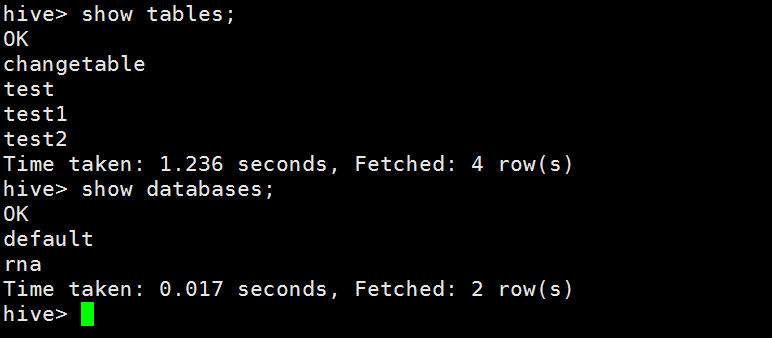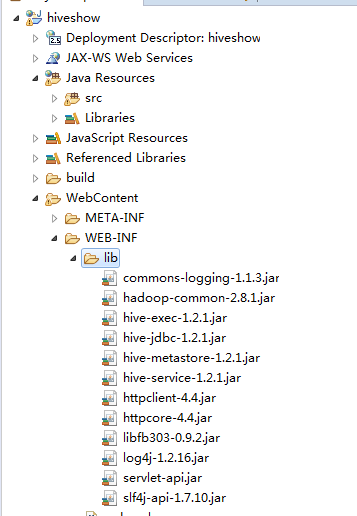Hive的用處,就是把hdfs里的文件建立映射轉化成資料庫的表 但hive里的sql語句都是轉化成了mapruduce來對hdfs里的數據進行處理 ,並不是真正的在資料庫里進行了操作。 而那些表的定義則是儲存在了mysql資料庫中,他只是記錄相應表的定義 所以你的集群中要有一臺機器裝了mysql 裝 ...
Hive的用處,就是把hdfs里的文件建立映射轉化成資料庫的表
但hive里的sql語句都是轉化成了mapruduce來對hdfs里的數據進行處理
,並不是真正的在資料庫里進行了操作。
而那些表的定義則是儲存在了mysql資料庫中,他只是記錄相應表的定義
所以你的集群中要有一臺機器裝了mysql
裝hive,裝到哪都行

然後解壓tar –zxvf xxxxx –C apps
然後進入到這個目錄里下的conf里
創建hive-site.xml文件

告訴他mysql在哪,連接驅動是啥,用戶名和密碼
然後進入lib目錄下,把jdbc jar 包放到該目錄下
然後是啟動hive
你的hadoop和hive要配置的有環境變數
echo $PATH //可以查看配置的環境變數
echo $HADOOP-HOME //可以查看具體的哪一個
然後最好把hadoop和yarn都啟動起來
然後再安裝目錄里bin/hive就可以啟動了

預設的是default資料庫
創建資料庫和表都會在真正的hdfs裡面創建目錄

然後如果你要是想往表裡面導數據,你需要把相應的文件用 ^A 來分割放到hdfs里的相應目錄下

然後把這個文件上傳到hdfs裡面
hadoop fs -put stu.info /user/hive/warehouse/t_big24/
在hive交互頁面中,顯示當前庫
設置一些基本參數,讓hive使用起來更便捷,比如:
1、讓提示符顯示當前庫:
hive>set hive.cli.print.current.db=true;
2、顯示查詢結果時顯示欄位名稱:
hive>set hive.cli.print.header=true;
但是這樣設置只對當前會話有效,重啟hive會話後就失效,解決辦法:
在linux的當前用戶目錄中,編輯一個.hiverc文件,將參數寫入其中:
vi .hiverc
|
set hive.cli.print.header=true; set hive.cli.print.current.db=true; |
配置hive環境變數
比如我hive是解壓在 /root/apps/hive-1.2.1
Vi /etc/profile
然後在最後加上
Export HIVE_HOME=/root/apps/hive-1.2.1
Export PATH=$PATH:$JAVA_HOME/bin:$HADOOP_HOME/bin:$HADOOP_HOME/sbin:$HIVE_HOME/bin
還可以把hive當成一個服務,使用客戶端來訪問這個服務
服務埠號10000
啟動hive服務
bin/hiveserver2
然後可以在linux監聽埠號netstat -nltp
啟動成功後,可以在別的節點上用beeline去連接
啟動服務 bin/beeline
然後要連接他
!connect jdbc:hive2://hdp-01:10000
然後輸入賬戶root 沒有密碼
課外知識 標準輸出重定向。Linux里1就是標準輸出
./linux腳本文件 1>/要輸入的文件名 2>/錯誤時要定向到的文件名 &
這樣就不會再終端列印了
/dev/null 是一個“黑洞”什麼東西都會刪除
上述啟動,會將這個服務啟動在前臺,如果要啟動在後臺,則命令如下:
nohup bin/hiveserver2 1>/dev/null 2>&1 &
前面加上nohup就是就算這個用戶退出,這個進程也會繼續
hive -e "sql命令"
這樣可以不用進到hive直接運行
然後,進一步,可以將上述命令寫入shell腳本中,以便於腳本化運行hive任務,並控制、調度眾多hive任務,示例如下:
vi t_order_etl.sh
|
#!/bin/bash hive -e "select * from db_order.t_order" hive -e "select * from default.t_user" hql="create table default.t_bash as select * from db_order.t_order" hive -e "$hql" |
如果要執行的hql語句特別複雜,那麼,可以把hql語句寫入一個文件:
vi x.hql
|
select * from db_order.t_order; select count(1) from db_order.t_user; |
然後,用hive -f /root/x.hql 來執行
use db_order;
create table t_order(id string,create_time string,amount float,uid string);
表建好後,會在所屬的庫目錄中生成一個表目錄
/user/hive/warehouse/db_order.db/t_order
只是,這樣建表的話,hive會認為表數據文件中的欄位分隔符為 ^A
正確的建表語句為:
create table t_order(id string,create_time string,amount float,uid string)
row format delimited
fields terminated by ',';
這樣就指定了,我們的表數據文件中的欄位分隔符為 ","
內部表(MANAGED_TABLE):表目錄按照hive的規範來部署,位於hive的倉庫目錄/user/hive/warehouse中
外部表(EXTERNAL_TABLE):表目錄由建表用戶自己指定
create external table t_access(ip string,url string,access_time string)
row format delimited
fields terminated by ','
location '/access/log';
外部表和內部表的特性差別:
1、內部表的目錄在hive的倉庫目錄中 VS 外部表的目錄由用戶指定
2、drop一個內部表時:hive會清除相關元數據,並刪除表數據目錄
3、drop一個外部表時:hive只會清除相關元數據;
分區表的實質是:在表目錄中為數據文件創建分區子目錄,以便於在查詢時,MR程式可以針對分區子目錄中的數據進行處理,縮減讀取數據的範圍。
比如,網站每天產生的瀏覽記錄,瀏覽記錄應該建一個表來存放,但是,有時候,我們可能只需要對某一天的瀏覽記錄進行分析
1、創建帶分區的表
|
create table t_access(ip string,url string,access_time string) partitioned by(dt string) row format delimited fields terminated by ','; |
註意:分區欄位不能是表定義中的已存在欄位
向分區中導入數據
load data local inpath '/root/access.log.2017-08-04.log' into table t_access partition(dt='20170804');
load data local inpath '/root/access.log.2017-08-05.log' into table t_access partition(dt='20170805');
針對分區數據進行查詢
統計8月4號的總PV:
select count(*) from t_access where dt='20170804';
實質:就是將分區欄位當成表欄位來用,就可以使用where子句指定分區了
建表:
create table t_partition(id int,name string,age int)
partitioned by(department string,sex string,howold int)
row format delimited fields terminated by ',';
導數據:
load data local inpath '/root/p1.dat' into table t_partition partition(department='xiangsheng',sex='male',howold=20);
可以通過已存在表來建表:
1、create table t_user_2 like t_user;
新建的t_user_2表結構定義與源表t_user一致,但是沒有數據
2、在建表的同時插入數據
|
create table t_access_user as select ip,url from t_access; |
t_access_user會根據select查詢的欄位來建表,同時將查詢的結果插入新表中
1.1.1. 將hive表中的數據導出到指定路徑的文件
1、將hive表中的數據導入HDFS的文件
insert overwrite directory '/root/access-data'
row format delimited fields terminated by ','
select * from t_access;
2、將hive表中的數據導入本地磁碟文件
insert overwrite local directory '/root/access-data'
row format delimited fields terminated by ','
select * from t_access limit 100000;
hql裡面的數據類型和普通的沒什麼區別
array數組類型
arrays: ARRAY<data_type> (Note: negative values and non-constant expressions are allowed as of Hive 0.14.)
示例:array類型的應用
假如有如下數據需要用hive的表去映射:
|
戰狼2,吳京:吳剛:龍母,2017-08-16 三生三世十里桃花,劉亦菲:癢癢,2017-08-20 |
設想:如果主演信息用一個數組來映射比較方便
建表:
create table t_movie(moive_name string,actors array<string>,first_show date)
row format delimited fields terminated by ','
collection items terminated by ':';
導入數據:
load data local inpath '/root/movie.dat' into table t_movie;
查詢:
select * from t_movie;
select moive_name,actors[0] from t_movie;
select moive_name,actors from t_movie where array_contains(actors,'吳剛');
select moive_name,size(actors) from t_movie;
map類型
1) 假如有以下數據:
|
1,zhangsan,father:xiaoming#mother:xiaohuang#brother:xiaoxu,28 2,lisi,father:mayun#mother:huangyi#brother:guanyu,22 3,wangwu,father:wangjianlin#mother:ruhua#sister:jingtian,29 4,mayun,father:mayongzhen#mother:angelababy,26 |
可以用一個map類型來對上述數據中的家庭成員進行描述
2) 建表語句:
create table t_person(id int,name string,family_members map<string,string>,age int)
row format delimited fields terminated by ','
collection items terminated by '#'
map keys terminated by ':';
3) 查詢
select * from t_person;
## 取map欄位的指定key的值
select id,name,family_members['father'] as father from t_person;
## 取map欄位的所有key
select id,name,map_keys(family_members) as relation from t_person;
## 取map欄位的所有value
select id,name,map_values(family_members) from t_person;
select id,name,map_values(family_members)[0] from t_person;
## 綜合:查詢有brother的用戶信息
|
select id,name,father from (select id,name,family_members['brother'] as father from t_person) tmp where father is not null; |
struct類型
1) 假如有如下數據:
|
1,zhangsan,18:male:beijing 2,lisi,28:female:shanghai |
其中的用戶信息包含:年齡:整數,性別:字元串,地址:字元串
設想用一個欄位來描述整個用戶信息,可以採用struct
2) 建表:
create table t_person_struct(id int,name string,info struct<age:int,sex:string,addr:string>)
row format delimited fields terminated by ','
collection items terminated by ':';
3) 查詢
select * from t_person_struct;
select id,name,info.age from t_person_struct;
其他的執行語句和sql裡面的是基本一樣的
註意: 一旦有group by子句,那麼,在select子句中就不能有 (分組欄位,聚合函數) 以外的欄位
## 為什麼where必須寫在group by的前面,為什麼group by後面的條件只能用having
因為,where是用於在真正執行查詢邏輯之前過濾數據用的
having是對group by聚合之後的結果進行再過濾;
上述語句的執行邏輯:
1、where過濾不滿足條件的數據
2、用聚合函數和group by進行數據運算聚合,得到聚合結果
3、用having條件過濾掉聚合結果中不滿足條件的數據
假如有以下數據:
|
1,zhangsan,化學:物理:數學:語文 2,lisi,化學:數學:生物:生理:衛生 3,wangwu,化學:語文:英語:體育:生物 |
映射成一張表:
create table t_stu_subject(id int,name string,subjects array<string>)
row format delimited fields terminated by ','
collection items terminated by ':';

然後,我們利用這個explode的結果,來求去重的課程:
|
select distinct tmp.sub from (select explode(subjects) as sub from t_stu_subject) tmp; |
然後java代碼操作的話,需要現在伺服器上開啟hive2服務,這個跟上面使用beeline連接hive是一個道理

需要的包在解壓後的hive裡面都有
import java.sql.Connection;
import java.sql.DriverManager;
import java.sql.SQLException;
public class getConnection {
public getConnection() {
}
public static Connection getConnection() throws ClassNotFoundException, SQLException {
Class.forName("org.apache.hive.jdbc.HiveDriver");
Connection connection = DriverManager.getConnection("jdbc:hive2://hdp-02:10000/test","root","123456");
return connection;
}
}
這樣就可以獲得一個連接
import java.sql.Connection;
import java.sql.ResultSet;
import java.sql.SQLException;
import java.sql.Statement;
public class getData {
public getData() {
}
public static void getdata() throws ClassNotFoundException, SQLException {
Connection connection = getConnection.getConnection();
Statement statement = connection.createStatement();
String sql = "select * from people";
ResultSet res = statement.executeQuery(sql);while(res.next()) {
System.out.println(res.getString(1) + " " + res.getString(2) + " " + res.getString(3) + " " + res.getString(4));
}
res.close();
statement.close();
connection.close();
return res;
}
}
這個其實和連接普通的mysql也沒啥區別........


